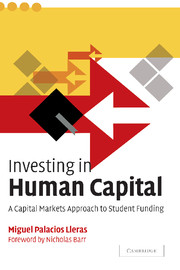Book contents
- Frontmatter
- Contents
- List of figures
- List of tables
- Foreword
- Acknowledgments
- Introduction
- Part I The problem of financing education
- 1 The value of education
- 2 Market failure in the financing of education
- 3 The need for alternatives to traditional funding
- Part II Equity-like investments to finance education
- Part III Implementing human capital contracts
- Appendix A Valuation of human capital contracts
- Appendix B Using human capital options to value income-contingent loans
- Appendix C Features of human capital contracts, income-contingent loans, and traditional mortgage-type loans
- Appendix D A developing country study
- Notes
- References
- Index
2 - Market failure in the financing of education
Published online by Cambridge University Press: 08 January 2010
- Frontmatter
- Contents
- List of figures
- List of tables
- Foreword
- Acknowledgments
- Introduction
- Part I The problem of financing education
- 1 The value of education
- 2 Market failure in the financing of education
- 3 The need for alternatives to traditional funding
- Part II Equity-like investments to finance education
- Part III Implementing human capital contracts
- Appendix A Valuation of human capital contracts
- Appendix B Using human capital options to value income-contingent loans
- Appendix C Features of human capital contracts, income-contingent loans, and traditional mortgage-type loans
- Appendix D A developing country study
- Notes
- References
- Index
Summary
From this chapter onwards the discussion will focus on higher and vocational education, also understood as non-compulsory and post-compulsory education (in contrast to compulsory education). Because we are more familiar with the term “higher education,” I shall use it throughout this book. However, the arguments I present apply to vocational training as well.
Higher-education students behave in fundamentally different ways from compulsory-age ones. There are two important differences that are particularly relevant. First, the goals of compulsory education are different from those of non-compulsory education. In the former, students are introduced to a set of fundamental common values to be required for them to live in society. In the latter, students learn mainly for their own benefit. Second, school-age children, the direct consumers of compulsory education, are not capable of deciding how to obtain their education. In contrast, higher-education students are considered informed consumers making rational decisions regarding their fields of study (see Barr, 2001). As a result of these differences, the potential for market failures in financing compulsory education are greater than in the financing of higher education.
Economic theory predicts that attractive opportunities for investment will disappear rapidly in the absence of structural barriers that prevent profit-seeking investors from taking those investment opportunities. Chapter 1suggested that those structural barriers do exist in education. They are the reasons why there is under-investment in education, why students refrain from making the investment, and why investors shy away from financing it.
- Type
- Chapter
- Information
- Investing in Human CapitalA Capital Markets Approach to Student Funding, pp. 22 - 29Publisher: Cambridge University PressPrint publication year: 2004



